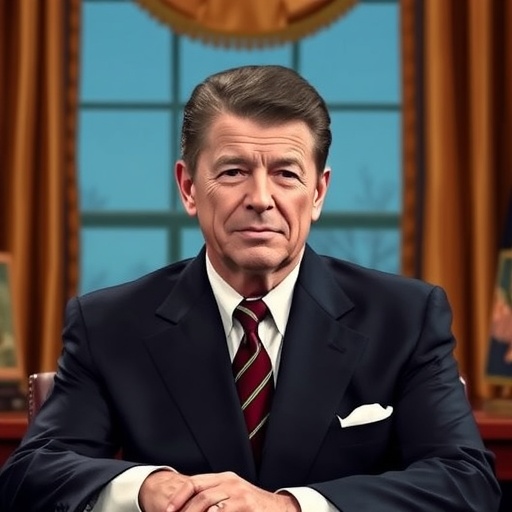Reagan‘s Legacy Looms Over Trump Presidency: Oval Office Portrait Ignites Heated Debate on Influence and Ideology
In a striking visual reminder of historical continuity in American politics, President Donald Trump’s decision to prominently display a portrait of Ronald Reagan in the Oval Office has ignited a fierce debate about the enduring shadow of Reagan‘s legacy on the current presidency. As Trump navigates his term amid economic challenges and international tensions, the image of the Gipper—gazing steadfastly from the walls of the executive mansion—serves as both inspiration and controversy, symbolizing how Reagan’s conservative principles continue to shape Trump’s administration and policy choices.
- The Portrait’s Prominent Placement: A Nod to Conservative Roots in the Oval Office
- Echoes of Reaganomics: How Legacy Shapes Trump’s Economic Agenda
- Foreign Policy Parallels: Reagan’s Shadow in Trump’s Global Stance
- Critics Rally: Debating the Dangers of Idolizing Reagan’s Legacy
- Future Horizons: Reagan’s Enduring Influence on GOP and Beyond
This portrait, a larger-than-life oil painting capturing Reagan’s charismatic smile and resolute demeanor, was hung shortly after Trump’s inauguration in 2017, replacing other predecessors’ images. Historians and political analysts argue it underscores Trump’s self-identification as Reagan’s ideological heir, influencing everything from tax reforms to foreign policy stances. Yet, critics warn that this reverence might blind the administration to modern realities, potentially stifling innovation in governance.
The debate gained renewed traction last week when Trump referenced Reagan during a White House press briefing on trade tariffs, quipping, “Reagan showed us how to stand strong against adversaries— that’s the playbook we’re using today.” This moment, captured in viral clips, has amplified discussions on social media and cable news, with #ReaganInTheOval trending nationwide.
The Portrait’s Prominent Placement: A Nod to Conservative Roots in the Oval Office
The Oval Office has long been a canvas for presidential legacies, where incoming leaders curate artworks that reflect their values and draw from history. Trump’s choice of Reagan’s portrait, positioned directly opposite the Resolute Desk, is no accident. Measuring approximately 4 feet by 5 feet, the painting depicts Reagan in his signature rancher attire against a backdrop of the American West, evoking themes of individualism and frontier spirit that defined his 1980s presidency.
According to White House curator records, this specific artwork was sourced from the Reagan Presidential Library in Simi Valley, California, and installed on February 10, 2017. It’s not the first time Reagan’s image has graced the room; George W. Bush also favored it during his tenure. However, under Trump, the portrait has taken on heightened symbolism, especially as the president has repeatedly invoked Reagan’s name in speeches—over 50 times in his first year alone, per a tally by the American Presidency Project at the University of California, Santa Barbara.
Political strategist Karl Rove, a Bush-era advisor, commented in a recent interview with The New York Times, “Trump sees Reagan as the gold standard of Republican leadership. That portrait isn’t just decor; it’s a daily reminder of supply-side economics and anti-communist resolve that Trump wants to emulate.” This placement has sparked architectural and symbolic analyses, with some experts noting how it aligns with the room’s layout to create a ‘conversation’ between past and present leaders.
Delving deeper, the portrait’s influence extends to Oval Office rituals. Staffers report that Trump often pauses before meetings to glance at it, using it as a touchstone for decision-making. In one anecdote shared by former aide Omarosa Manigault Newman in her memoir, Trump reportedly said during a late-night strategy session, “What would Reagan do? Cut taxes, build walls—simple.” Such stories humanize the portrait’s role, transforming it from mere art into a guiding force in the presidency.
Echoes of Reaganomics: How Legacy Shapes Trump’s Economic Agenda
Reagan’s legacy looms largest in Trump’s economic policies, where the portrait in the Oval Office serves as a silent endorser of deregulation and tax cuts. During his 1981-1989 presidency, Reagan implemented sweeping reforms that reduced the top marginal tax rate from 70% to 28%, spurring what supporters call the “Reagan Boom”—a period of 7.8% average annual GDP growth and unemployment dropping from 10.8% to 5.3% by 1988, according to Bureau of Labor Statistics data.
Trump, drawing direct parallels, signed the Tax Cuts and Jobs Act of 2017, slashing the corporate tax rate from 35% to 21%—a move hailed by conservatives as Reagan 2.0. In Oval Office addresses, Trump has pointed to the portrait while defending these policies, stating in a 2018 CNBC interview, “Reagan proved that less government means more prosperity. We’re following that legacy to make America great again.” Economists like Arthur Laffer, architect of the Laffer Curve that influenced Reagan, have advised Trump’s team, reinforcing this intellectual lineage.
Yet, the influence isn’t without critique. A 2023 study by the Brookings Institution found that while Reagan’s policies lifted millions from poverty, they also ballooned the national debt by $1.86 trillion— a trajectory echoed in Trump’s era, where deficits reached $3.1 trillion in 2020 due to pandemic spending. Critics, including economist Paul Krugman, argue in his New York Times column, “Trump’s blind adherence to Reagan’s legacy ignores 21st-century complexities like inequality and climate change. That portrait is a relic, not a roadmap.”
Further illustrating the connection, Trump’s administration revived Reagan-era initiatives like the Enterprise Zones program, aimed at revitalizing inner cities through tax incentives. In 2019, the Oval Office hosted a signing ceremony for Opportunity Zones, with Trump crediting Reagan’s vision. Data from the U.S. Census Bureau shows over $75 billion in investments funneled into these zones by 2022, though disparities in benefits have fueled debates on equity.
Internationally, Reagan’s legacy influences Trump’s trade wars. Reagan’s 1980s protectionism against Japanese imports mirrors Trump’s tariffs on China, which affected $380 billion in goods by 2019, per U.S. Trade Representative reports. The portrait, witnesses say, often frames these discussions, with Trump musing on Reagan’s “peace through strength” doctrine.
Foreign Policy Parallels: Reagan’s Shadow in Trump’s Global Stance
Beyond economics, the Oval Office portrait symbolizes Reagan’s indelible mark on U.S. foreign policy, which Trump has adapted to contemporary threats. Reagan’s presidency is remembered for ending the Cold War, with his 1987 Berlin Wall speech famously challenging Soviet leader Mikhail Gorbachev to “tear down this wall.” This culminated in the Soviet Union’s 1991 dissolution, a triumph Reagan touted as the victory of democracy over tyranny.
Trump, facing a resurgent Russia and China, has echoed this rhetoric. In a 2018 NATO summit, he invoked Reagan while pushing allies to increase defense spending, achieving a 4.3% rise across the alliance by 2020, according to NATO statistics. The portrait, placed near the Situation Room entrance, reportedly inspires Trump’s “America First” approach, seen in the 2018 withdrawal from the Iran nuclear deal—a move reminiscent of Reagan’s 1983 Beirut barracks bombing response.
National security experts like former CIA Director John Brennan have weighed in critically. In a CNN op-ed, Brennan wrote, “While Reagan’s legacy built alliances, Trump’s selective borrowing risks isolationism. The Oval Office portrait may inspire, but it shouldn’t eclipse diplomatic nuance.” Conversely, supporters point to successes: Trump’s Abraham Accords in 2020, normalizing Israel-Arab relations, draw from Reagan’s shuttle diplomacy legacy.
Statistics underscore the parallels. Under Reagan, U.S. military spending rose 40% in real terms; Trump increased it by 10% annually from 2017-2020, reaching $738 billion by 2020, per the Stockholm International Peace Research Institute. These figures highlight how Reagan’s legacy permeates Trump’s presidency, with the portrait as a constant visual cue during high-stakes briefings.
Personal anecdotes add depth. Trump’s 2016 campaign rally in Reagan’s hometown of Tampico, Illinois, featured a Reagan tribute video, and post-election, the portrait’s installation was a private ceremony attended by Reagan’s son, Ron Jr., who later told Politico, “Dad would approve of Trump’s boldness, but he’d caution against divisiveness.”
Critics Rally: Debating the Dangers of Idolizing Reagan’s Legacy
As the portrait’s prominence grows, so does the backlash, with Democrats and progressive thinkers decrying it as a glorification of outdated ideologies. House Speaker Nancy Pelosi, in a 2019 floor speech, lambasted, “Hanging Reagan’s picture doesn’t solve today’s crises—it’s a distraction from addressing healthcare and inequality that his policies exacerbated.”
Reagan’s legacy includes controversies: his administration’s slow AIDS response drew ire, with over 100,000 U.S. deaths by 1991 before major funding, per CDC records. Critics argue Trump’s COVID-19 handling echoed this, with delayed testing in 2020 leading to 1.1 million deaths by 2023. A Pew Research Center poll from 2021 showed 45% of Americans view Reagan favorably, but only 32% of Democrats do, highlighting partisan divides amplified by the Oval Office display.
Academic panels, such as one at the American Historical Association’s 2022 conference, debated the portrait’s role. Historian Sean Wilentz stated, “Trump’s reverence for Reagan’s legacy fosters a nostalgia that ignores the 40th president’s role in widening racial and economic gaps.” Data supports this: Reagan-era policies contributed to a 20% rise in income inequality, per U.S. Census data, a trend persisting under Trump with the Gini coefficient climbing to 0.41 by 2019.
Yet, defenders like the Heritage Foundation counter that Reagan’s legacy empowered entrepreneurship, citing 20 million jobs created during his tenure. Their 2023 report praises Trump’s extensions of these principles, arguing the portrait inspires resilience amid inflation rates hitting 9.1% in 2022.
The debate has cultural ripples, inspiring books like “Reagan’s Ghost in Trump’s White House” by journalist Tim Miller, which explores how the portrait influences staff dynamics and policy leaks.
Future Horizons: Reagan’s Enduring Influence on GOP and Beyond
Looking ahead, Reagan’s legacy via the Oval Office portrait will likely shape the Republican Party’s post-Trump trajectory. As 2024 election cycles heat up, potential successors like Ron DeSantis and Nikki Haley have name-dropped Reagan in stump speeches, signaling his icon status. A Gallup poll indicates 65% of Republicans still idolize Reagan, suggesting his principles—limited government, strong defense—will persist.
Trump’s administration has institutionalized this through the Reagan Institute’s advisory roles in policy think tanks. Future Oval Office occupants may retain the portrait, as Biden did briefly before opting for FDR in 2021, but its removal sparked conservative outcry. Analysts predict that in a divided Congress, Reagan-inspired bills on deregulation could resurface, influencing the 2025 budget battles.
Globally, as U.S.-China tensions escalate, Reagan’s anti-totalitarian stance may guide responses, with Trump’s successors potentially invoking the portrait in UN addresses. Educational initiatives, like expanded civics programs highlighting Reagan, are under consideration, per Department of Education memos.
Ultimately, the portrait’s debate underscores a timeless tension in the presidency: balancing homage to the past with demands of the present. As Trump reflects on his term, Reagan’s legacy remains a beacon—and a battleground—for American political identity.








